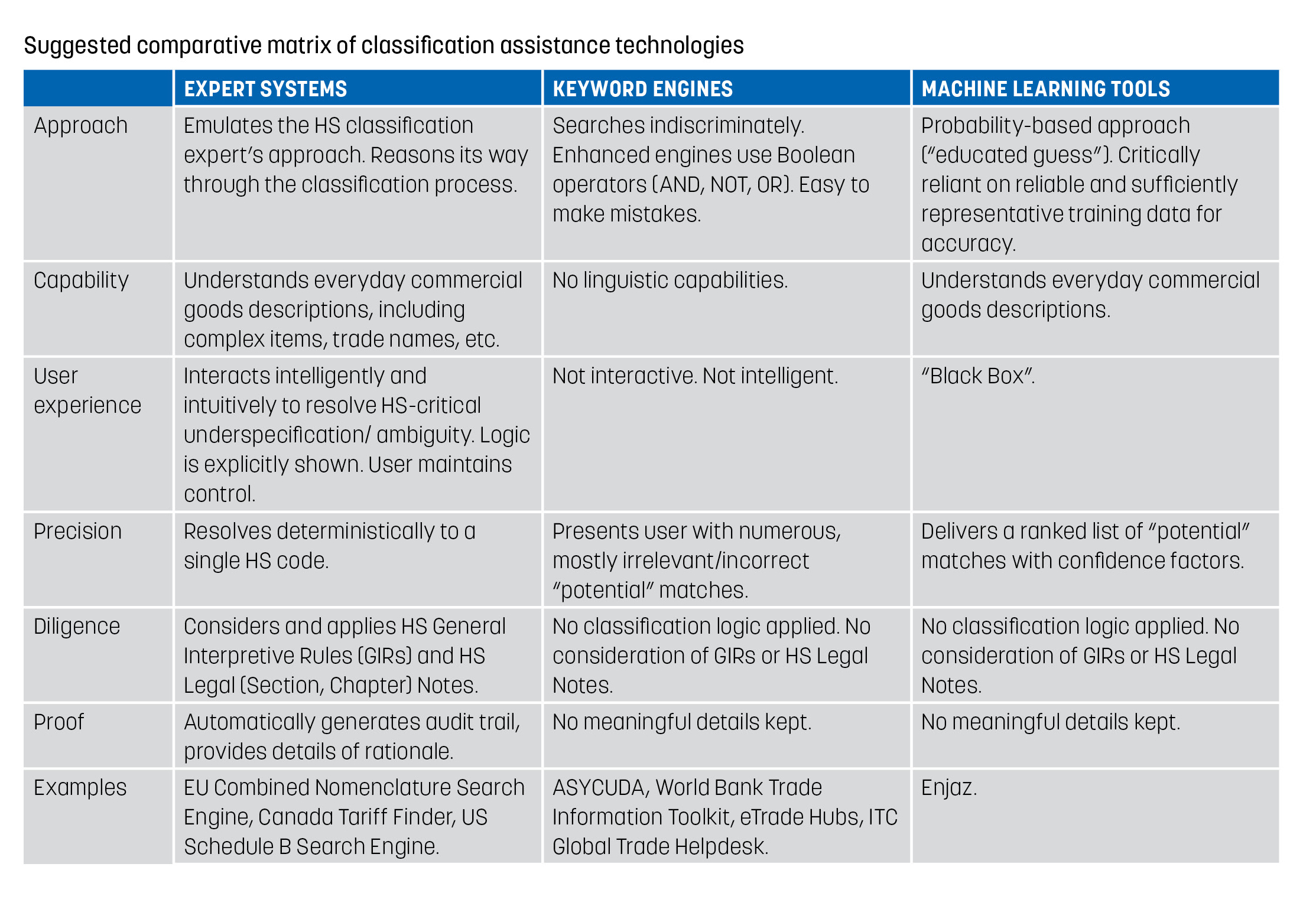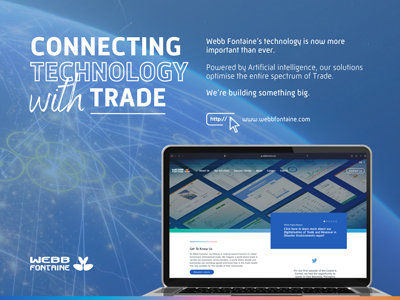What impact is technology having on efforts to improve HS classification efficiency and accuracy?
24 February 2022
By Randy Rotchin, Director of Business Development & Global Trade, AvalaraOne of the main topics of discussion during the 2019 WCO Conference on the Future Direction of the Harmonized System (HS) was HS complexity. Concern was expressed about the difficulty of HS classification especially for small and medium-sized enterprises that are being granted the opportunity to participate in the global economy but don’t necessarily possess the tools needed to do so.
The fact is that HS classification remains largely a manual process for most enterprises. A whopping 95% of respondents to a 2016 Thomson Reuters/KPMG survey reported having difficulty with HS classification. This difficulty manifests itself in unacceptable rates of classification error. For example, the Auditor General of Canada, in several reports to the country’s parliament, has identified error rates of 20% and higher.
The WCO offers a plethora of important resources to assist classification, such as the Explanatory Notes and Opinions. For the average declarant, however, who may be challenged with classifying thousands, tens of thousands, or even millions of commodities in a timely manner, these resources may not be as helpful. The WCO tools are essentially repositories of information which are of limited use to the vast majority of individuals whose HS literacy and experience is either nominal or non-existent.
Traditionally, the antidote to a lack of knowledge was training. While there is no substitute for training, it takes time and money, and very few organizations devote nearly enough of either precious resource to such endeavours. The UK Customs Academy, which was created to provide Customs compliance training to British traders in advance of Brexit, devotes a total of 40 hours of instruction to cover such mission critical areas as “Customs Processes and Procedures”, “Calculating Import Duty”, “Customs Declarations” and “Export and Import Controls.” The WCO Academy offers five sector-specific courses on HS classification alone – totalling 58 hours.
A more realistic assessment of the number of hours needed to achieve HS classification competency was perhaps revealed in a 2020 poll of LinkedIn Customs Specialist Group members, 92% of whom answered “at least 100 hours.” Within this group of experts, more than a third indicated that more than 500 hours of HS training was necessary.
So, the question then becomes: if rich libraries of information and training do not offer practical solutions to the real problem of HS classification errors and efficiencies for the average trader, can technology help? In short, yes. However, the effectiveness will depend on what kind of technology is applied.
There are currently three basic types of technology that are used to power classification assistance tools: keyword search engines, expert systems and machine learning algorithms.
Keyword search tools
The most ubiquitous of the technologies used to power classification assistance tools use keyword search operators. You’ll find these tools in one form or another in Customs management systems, electronic single windows and trade information portals such as UNCTAD’s ASYCUDA, the World Bank-designed Vietnam Trade Information Portal and the ITC’s Market Access Map and Rules of Origin Facilitator, respectively.
Keyword search tools work by trying to match the words or phrases that users submit with those in the target document. Unfortunately, this process is deeply flawed and constitutes the automated tool’s Achilles heel. If the user does not enter a word or phrase that is explicitly used in the nomenclature, the engine will offer no results. For example, everyday commercial goods descriptions such as “baby food” and “egg timer” (described in the HS as “homogenized composite food preparations” and ““apparatus for measuring, recording or otherwise indicating intervals of time””, respectively) yield no results. Keyword engines demand that the user be familiar with the Harmonized System’s often impenetrable terminology to retrieve any results at all.
When a keyword match is found, these tools return long lists of mostly irrelevant and erroneous “potential” matches. Again, forcing the user to have some understanding of the process of classification and the content of the nomenclature in order to identify the most appropriate code from among the many “potentials” presented. Achieving accuracy is almost impossible when the appropriate code is one that associates to a residual heading/subheading (i.e. whereby the HS commodity description is “Other”).
Some keyword engines have been enhanced with Boolean operators which are simple words (AND, OR, NOT or AND NOT) used as conjunctions to combine or exclude keywords in a search, and which presumably produce more relevant search results. Others have added synonyms to their engines to help bridge the profound gap between commercial and HS terminology. Nevertheless, there is no getting around the fact that keyword search engines are only capable of providing results if they find an exact or partial keyword match in the document or database they are searching.
A search for “computer” in the Barbados Government’s Electronic Trade System typifies the problem with keyword search engines. The tool found two potential matches, both of which are incorrect: 4821.10.00.900 (“Pricing tags, over printed labels, computer and copier labels”) and 4821.90.00.900 (“Other pricing tags, over printed labels, computer and copier labels”). To find the appropriate code for “computer”, the declarant will have to know that such machines are described in the HS nomenclature as “automatic data processing machines”.
Keyword engines can hardly be called classification assistance tools, as they have not been designed for the specific purpose of HS classification. They do not consider or apply the General Interpretive Rules (GIRs) or Legal Notes.
Expert systems
Expert systems are a branch of applied artificial intelligence (AI) which, in the context of this discussion, have been built specifically to address the particular challenges associated with HS classification. These challenges include:
- matching declarants’ commonly used commercial goods descriptions to HS terminology;
- properly handling complex items such as parts and sets/kits;
- considering and applying HS General Interpretive Rules and Legal Notes; and
- recognizing and addressing underspecification and ambiguity.
The expert systems that have been designed and deployed as HS classification assistance tools (e.g. the United States Census Bureau Schedule B Search Engine, the Canada Tariff Finder and the Federal German Government’s Warenverzeichnis Online search engine (Suchmaschine) look like simple keyword search engines, but that is where the similarity ends.
Unlike the keyword engines which search indiscriminately and require significant prior HS knowledge, these tools employ specific domain knowledge and rules of thumb and use reasoning tools to drive the commodity classification process intelligently and intuitively to a single code.
A search for a “corkscrew” in the European Commission’s Combined Nomenclature Search Engine illustrates the attractive properties of an expert system-based classification assistance tool. The tool recognizes that the “corkscrew” is underspecified and asks if it is powered mechanically, electro-mechanically or otherwise. Depending on how this question is answered, either an HS code is delivered or one or more other multiple-choice questions are asked until a single HS code is reached. The process of classification has been automated to some degree yet is still completely within the control of the declarant. The tool makes inferences and assumptions and responds to user specified input, ultimately providing a recommendation that has been generated through the consideration and application of GIRs and HS Legal Notes.
Expert system-based classification assistance tools have successfully demonstrated the ability to make consistent and accurate recommendations and result in a faster learning curve for beginners. One national Customs authority reported that the deployment of its classification assistance tool resulted in improvements of declaratory data quality of 46%, classification accuracy of 22% and fiscal compliance of 29% over a two-year period.
Machine learning algorithms
The latest application of advanced technology in the Customs compliance sphere is machine learning (ML). In basic terms, ML is a form of artificial intelligence that makes predictions from data. The power of ML is that it uses algorithms and statistical models to learn and adapt without the need for explicit programming instructions. Machine learning is stochastic (i.e. it has a random probability distribution or pattern that may be analysed statistically but not predicted precisely), so the predictions generated by ML algorithms are, fundamentally, educated guesses.
ML’s critical success factor is the data used to train the system. For an ML algorithm to be reliable, the data must be sufficient, representative and reliably labelled.
“While the caustic observation ‘garbage-in, garbage-out’ has plagued analytics and decision-making for generations, it carries a special warning for machine learning,” warned Thomas Redman in a 2018 Harvard Business Review article. “The quality demands of machine learning are steep, and bad data can rear its ugly head twice – first in the historical data used to train the predictive model and second in the new data used by that model to make future decisions.”
For the purpose of HS classification, “labelling” means mapping narrative commercial goods descriptions accurately to HS codes – a task that can be performed either manually (supervised) or automatically (unsupervised). Additionally, questions remain about whether or not it is even possible to build a reliable model that can be used universally across a broad set of declaratory data. This is because declarants describe their goods in infinitely diverse and idiosyncratic ways, and only ML models built upon very specific and controlled training data can be relied upon.
One example of a publicly available classification assistance tool that claims to use an ML algorithm is the Enjaz Customs Trade Portal’s “HS Code Classification using Artificial Intelligence” tool. The Enjaz tool reads complex goods descriptions and returns a list of possible matches, along with “probability” factors, which are presumably designed to provide users some indication of trustworthiness.
A search for an “automotive engine mount, steel” in the Enjaz tool, for example, yields two incorrect suggestions (8708.99 and 8409.99 … automotive engine mounts of steel are properly classified under 8302.30). More worrisome might be the fact that 8708.99 came with a probability of 95.76%.
Tools that leverage ML are undoubtedly more intelligent than the ones that rely on keyword operators; however, they possess many of the same shortcomings. They still demand that the user has a deep and thorough understanding of the rules that govern HS classification and a familiarity with the HS Nomenclature itself. More concerning than the keyword tools, however, is the fact that, because ML models are constantly re-learning, results may change over time.

Conclusion
Classification assistance tools are already important features of modern Customs management systems, trade information portals and electronic single windows. The various technologies being offered in these systems are, indeed, so different that it hardly seems fair to compare them. Yet, for a Customs authority, the technology that is chosen will be consequential.
In order to be of real, practical value for the average trader, HS classification assistance tools have to be intuitive, reliable and available.
Of the three main technologies used to assist HS classification, expert systems best meet the often conflicting objectives of both trade facilitation and Customs compliance. Facilitation is achieved through a more satisfying user experience – users describe their goods in everyday commercial language; the tools are intelligent and user-friendly; they always resolve to a single HS code; and they leave the ultimate control for classification in the hands of the user. Compliance is attained consistently and deterministically through the automatic consideration and application of complex rules and legal notes.
Still, tools of any kind, including but not limited to artificial intelligence-enabled tools, are just that – tools. They are designed to assist classification and not to perform classification. So, it stands to reason that the results they produce will only be as good as the people who use them. A chainsaw in one person’s hand will result in the building of a beautiful log cabin and in another person’s a tree landing on house.
More information
randy.rotchin@avalara.com
[1] http://asycuda.customs.gov.bb/portal/services/tariff/search.jsf
[2] https://uscensus.prod.3ceonline.com/
[3] https://www.tariffinder.ca/en/
[4] https://www.destatis.de/DE/Methoden/Klassifikationen/Aussenhandel/warenverzeichnis-aussenhandel-db-reguvis.html
[5] https://eurostat.prod.3ceonline.com
[6] https://portal.apcd.gov.ae/hscode-classification/?controller=home
Randy Rotchin is Director of Business Development & Global Trade at Avalara, which recently acquired 3CE Technologies.

